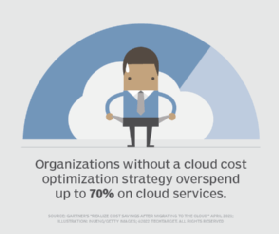
Ronald Hudson - Fotolia
Kick-start AWS cost reduction with these tools and techniques
Never turn your back on a cloud deployment. Learn how to tame AWS bills through capacity planning and governance practices, relying on CloudFormation, Cost Explorer and other AWS products.
Businesses can take manageable AWS cost reduction steps -- from simple tag schemas to full infrastructure-as-code adoption -- as long as they plan ahead and deploy the right tools and services.
The cost of an AWS cloud deployment depends on the workload. Does it need to flexibly scale with demand? What levels of availability are expected? Who has the ability to provision new environments? Cloud adopters make some common mistakes when they start to manage AWS resources, and small oversights can turn into big bills quickly.
Use these AWS cost reduction strategies to trim your bill and get ahead of runaway costs. They require relatively simple actions, from the occasional use of Spot Instances to programmatic tagging to standardized management processes and alerts. And many of these cost optimization best practices pair with tools natively available to AWS users, such as CloudFormation.
Refine your capacity planning
IT organizations face an ever-present challenge with capacity planning, both in terms of scale and hosting environment. Flexible capacity planning can be key to AWS cost control, thanks to lower-cost instances and resource scheduling.
Overprovisioning seems unavoidable, given how difficult it is to plan ahead, scope long-term projects and calculate growth. To lock in a lower hourly rate on AWS, organizations must reserve an instance in advance. Any project where the team incorrectly estimates resource demand can result in commitments that unnecessarily ratchet up the AWS bill.
AWS customers can use Spot Instances to manage EC2 costs. Spot Instances enable organizations to purchase unused capacity that AWS offers at sometimes substantial discounts. Customers can stretch their cloud budget for higher capacity than with Reserved Instances alone; however, a Spot Instance can be interrupted when the market price exceeds your prior bid price or when there isn't enough unused capacity to meet demand. Therefore, don't use Spot Instances for mission-critical applications that require consistent high availability.
Hosting choices also affect your AWS spending. If you choose the wrong instance types for an application, it results in unused, paid-for capacity. If a workload has steady resource consumption and the organization runs 24/7 servers, cloud spending itself could prove unnecessary. The more cost-effective choice in that scenario would be to maintain the workload on premises.

Capacity demands are not constant, especially with workloads designed to scale up and down on cloud resources. The simplest AWS cost reduction technique is to turn off instances when not in use. You can even automate this process with AWS Instance Scheduler.
For example, you can control costs by scaling down and turning off instances at 6 p.m. Friday for an application that's only accessed during business hours. Or initiate and pause EC2 and Relational Database Service instances as needed for an intermittent project. And consider disabling containers and shutting down test environments at a specific time to minimize often-overlooked development costs.
It's also beneficial to learn as much as possible about relevant cost structures and services when you plan your capacity and cost reduction initiatives. For example, Elastic Block Store (EBS) enables AWS users to mix and match storage volumes to EC2 instances as needed. However, AWS doesn't automatically delete EBS volumes when you eliminate an EC2 instance. Identifying and deleting those unattached volumes is a useful way to reduce AWS spending. You can also use Simple Monthly Calculator to estimate a new bill after cost-cutting procedures.
A proactive approach to cloud cost management also requires accountability and organizational policies. Independent business units can easily spin up new cloud instances that result in numerous, unchecked deployments -- a problem that likely didn't exist when IT supported all applications in-house. Establish governance mechanisms for accountability, and track usage. Investigate any deviations from the norm quickly to address problems and prevent that surprise bill.
Implement infrastructure as code
A manual, web-based approach to AWS management and infrastructure changes has significant drawbacks that indirectly drive up the cost of cloud investments.
Manual cloud operations are not reproducible, nor can a team evaluate the choices it's made. When you cannot reconstruct past actions, the chances of repeating costly mistakes are high. Manual cloud management also takes up a lot of IT staff members' time.
Use AWS CloudFormation templates to automatically create EC2 instances, security groups, subnets and load balancers. The native infrastructure-as-code tool constructs running instances and can help capacity planners and cloud ops to stay ahead of demand. CloudFormation can also automate cost reduction measures, such as halting an application and restarting it on a different instance according to changes in demand.
Get meta with cost allocation tags
To further control AWS costs, implement tagging as part of cloud management and monitoring.
Tags consist of metadata labels for deployed resources. These clear attributions establish cost accountability and aid cloud admins when they track active resources. You'll know who created resources and how they're being used -- or not used. Once you have assigned cost allocation tags to various resources, feed the info into AWS Cost Explorer to view spending based on each tagged group. You can also trigger alert thresholds that warn of capacity or compute changes threatening to raise costs by a certain percentage or dollar amount.
A sensible cost optimization strategy is crucial on AWS. Your company's AWS bills don't include project-specific resource usage data, so control, per-project cost estimates and resource management fall to the IT team. Admins and IT teams should regularly reevaluate cloud deployments as the business needs evolve. To keep AWS costs under control, dynamically monitor resources as they're consumed -- don't wait until the end of the billing cycle.







